 alt="Dali Erhai Lake Ecological Corridor from Xiaguan to Taoyuan"
/>
alt="Dali Erhai Lake Ecological Corridor from Xiaguan to Taoyuan"
/>
Wild Elephant Valley in Jinghong City, Xishuangbanna
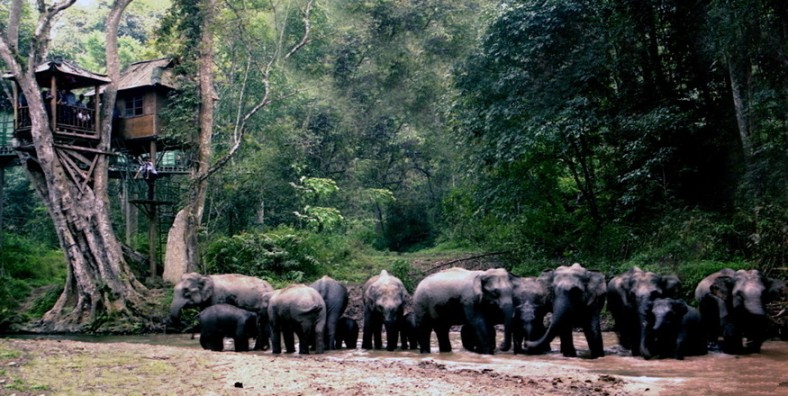
● Chinese Name: 野象谷
● English Name: Wide Ancient Elephants
● Keywords: Wild Elephants Valley Tickets, Asian Elephants, Elephants Show, Tropical Rain Forest
● Location: Mengyang Town, Jinghong City,Xishuangbanna, Yunnan Province
● Scenic Area: 3.69 square kilometers
● Opening Hours: 09:00-17:00 (4 to 5 hours for a visit)
Jinghong Wild Elephant Valley
Jinghong Wild Elephant Valley Forest Park (Chinese name: 野象谷公园) is a special theme park for Wild Asian Elephant sightseeing and observing and rainforest sightseeing. Wild Elephants Valley covers an area of 369 hectares by the Sancha River in Mengyang Town, and is situated 47 kilometers north of the city of Jinghong. With hills rolling gently at an altitude ranging between 747 and 1055 metres, the valley is covered by tropical rain forests, crisscrossed by rivers and streams, and teeming with such endangered species as Asian wild elephants, wild oxen, green peacocks and monkeys.
Why is the Wild Elephant Valley so special?
China’s wild elephant can only be found in the tropical forest in Xishuangbanna, while Wild Elephant Valley is the very place where you many find wild Asian Elephants much easier and more frequently. It is recorded that, there are about 130 wild Asian Elephant living in this region.
Where is the Wide Elephant Valley?
It locates in the south part of Mengyang Natural Protection Area, 45 km from Jinghong City. Park covers an area of 3,700,000 square meters, among which, building area is around 2,800 square meters, water area is up to 8000 square meters.
How to Get to Wide Elephant Valley?
From Jinghong: take bus in Jinghong Passenger Station to Guanping and stop in Wide Elephant Valley, RMB 15 per person.
From Simao: take bus to Mengla or Jinghong and stop at back door of Wide Elephant Valley.
In Wide Elephant Valley, traveles can take cableway for sightseeseeing, 50 yuan for one-way ticket, 70 yuan for round-trip ticket.
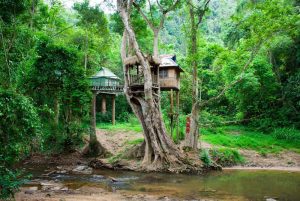
Main Attractions and Things to Do
Elephants Show
Outside the main scenic spots of the Wild Elephants Valley, tourists can appreciate wonderful performances given by the first elephant-domesticating school of China, the butterfly world inside the first butterfly-farming park in China, and the tropical birds in the hundred-bird park.The Wild Elepha annts Valley will show you a genuinely beautiful and mysterious Xishuangbanna.
The Elephant-domesticating School is the first of its kind in China. Visitors are able to appreciate performances given by adorable elephants. Well-trained elephants will salute visitors with formal bows, posed in a pyramid, headstand, dance to music, pass the single-log bridge, kick footballs, etc. Visitors can sit on an elephant or take photos with them. The show will going on 11:00-12:00 am, 2:00-3:00 pm every day.
National Elephants & International Elephants
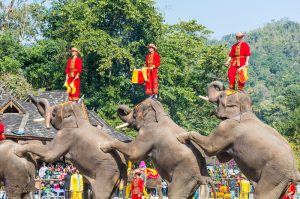
Xishuangbanna Wild Elephant & Nature Reserve lies at the crossroads between the eastern and western zones of the Mengyang Tourism Area, at 747–1055 meters above sea level. The reserve is made up of low hills and small hillocks, with wide valley bottoms rich in waterholes that contain enough salt to meet the biological needs of the wild Asian elephant. The wild elephant groups that roam about in the protection zone between Mengla and Mengyu are designated as National Elephants, while those that roam about inside the Mengla protection zone are designated as International Elephants, as the latter often come and go across the China-Laos border.
In China, wild elephants are only visible in the Wild Elephant Valley in Xishuangbanna. A flock of wild elephants appear in the Wild Elephant Valley within one or two days. There are observation towers for visitors watching wild elephants. Lucky tourists may have the chance to enjoy the scene of wild elephants bathing, playing and strolling. Tourist can also observe them by infrared binoculars at night. The best time to find wild elephants is at dawn or dusk.
Information about Wild Elephant Valley
City Zoo Habitat
The Xishuangbanna Wild Elephant & Nature Reserve, with its dense forest and its rich variety of animals and birds, many of which are rarely seen outside a zoo, is one of the few places in the world where wildlife can be viewed in its natural habitat, where it is us humans who are “caged in”, as it were, as we watch the wild animals and birds go about their daily lives with as little interference as possible from us humans, while still allowing us to witness these fantastic creatures in their natural setting. All of which makes Xishuangbanna Wild Elephant & Nature Reserve something of an open-air museum, but an open-air museum with a difference: these creatures cavort about in their natural habitat, not in a man-made, city zoo habitat.
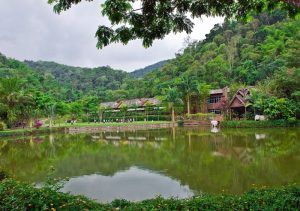
Four sites of interest to the visitor:
An Asian Elephant Breeding Center, established in Xishuangbanna by the Chinese government’s State Forestry Commission, but still under construction;
An Asian Elephant Ecological Observation Center;
The natural corridor, or ravine, where wild animals roam freely (and where the visitor may observe these animals via a cableway over the ravine), including – besides the wild elephants, of course – the bear and the water buffalo, and where there is a Python Pavilion, a Bird Park that is home to a number of rare birds, and a Butterfly Park;
And lastly, a Jinuo ethnic minority village with a tent camping facility offering campfire parties, and, for those who require a more tranquil stay, mountain huts for rent.
At the Jinuo village the visitor can observe first-hand the unique lifestyle of this special minority group, and, with a bit of luck, one might observe a Jinuo religious ceremony where ritualistic music is played involving the use of very large – and sacred – sun-drums (the Jinuo are animists, i.e., they believe, as do many other ethnic groups around the world, including American Indians, that all things, inanimate as well as animate, possess a spirit, the sun being especially sacred to the Jinuo etnic minority.
A Survey of the Reserve’s Natural Resources
The planned area of Xishuangbanna Wild Elephant & Nature Reserve is 369 hectares. The reserve is abundant in various natural resources including subtropical forests, tropical rainforests (these are found in the valleys below 800 meters above sea level), half-deciduous rainforests (distributed between 800-900 meters above sea level), and subtropical evergreen broad-leafed forests. And of course, there is the usual range of naturally-occuring wild animals in these various forest habitats. In addition, there are more than 400 types of plants on either side of the ravine that is home to the wild elephant herds, including the banyan, olive, and longan tree.
There are several groups, or families, of wild elephants living in the city zoo habitat, numbering about 60 head in all. They share the ravine with the bear, the wild buffalo, and the cobra, to name some of the more exotic species. It would be unfair not to point out that the reserve is also home to many wild birds which attract the attention not only of international bird experts, but also of groups of visiting bird-watchers.
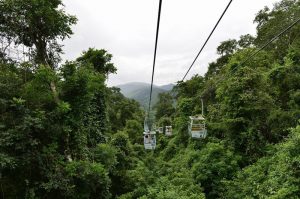
Asian Elephants versus African Elephants
China has traditionally been a breeding grounds for the Asian elephant (aka Indian elephant), which is somewhat smaller than its African cousin. Because of naturally-occurring as well as man-made changes in the wild elephant’s habitat over time, there are today only about 300 Asian elephants living and multiplying in the free on the virgin forest lands of Xishuangbanna Wild Elephant & Nature Reserve. The Asian elephant represents the largest land mammal native to China.
Compared to the African elephant, the Asian elephant weighs between 3-6 metric tons (the African elephant, between 4-7½ metric tons), has two cranial bulges with an indent in the center (the African elephant has only a single cranial bulge and thus no indent), has small, square-ish, slightly droopy ears (‘the ear of the African elephant is shaped like the African continent’, it is said; in any case, it slopes back and slightly upwards and outwards, masking the animal’s neck when seen in profile), has a lower lip that protrudes markedly and is tapered (the lower lip of the African elephant is rounder and hardly protrudes at all), and lastly, the Asian elephant has tusks that are generally shorter and lighter, even when they on occasion can reach the same length as those of the African elephant. Moreover, the tusks of the female Asian elephant are often only embryonic by comparison, and sometimes completely lacking (the tusks of the male are generally larger for both species*).
With its richly varied flora and fauna, its many streams and waterholes, and with the added state protection that the reserve enjoys, Xishuangbanna Wild Elephant & Nature Reserve is truly an ideal habitat for the many wild animals and birds that make their home here.
The two species cannot cross-breed – at least not successfully. The only known example of such a cross-breeding occurred in 1978 at Chester Zoo in the UK, and not by design. The staff had noticed that the African bull elephant, Jumbolino, flirted and eventually mated with the Asian cow elephant, Sheba, but no one expected a pregnancy to develop, since the two animals are not only of different species, they are of different genuses. In nature, cross-breeding between two different species generally leads to a hybrid (i.e., cannot reproduce), like the mule (a cross between the horse and the donkey), while cross-breeding between two different genuses was believed to be impossible. And indeed, it may very well be the case that even though offspring, by freak chance, may result via cross-breeding between different genuses, it cannot survive, as happened, alas, in the case of Motty, son of Jumbolino and Sheba, who died only two weeks after he was born.
Recommended Tours
1 Day North XishuangBanna Tour to Wild Elephant Valley and Jinuo Ethnic Village
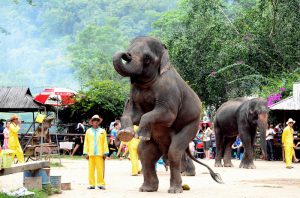
Best Time to Visit
Belonging to tropical rainforest climate, Xishuangbanna’s dry season is from November to April the next year and rainy season is from May to October. With annual average temperature of 21c, it has long summer and no winter. With cool and pleasant four seasons, the best time for traveling Xishuangbanna is from October to April the next year.
The Water-Splashing Festival, the most important festival for the Dai People to celebrate New Year, is usually celebrated in the middle of April.
Try to avoid Chinese public holidays, such as Labor Day (May 1st to 3rd) and National Day (October 1st to 7th). It is recommended that you start your day early so as to avoid crowds.
Useful Travel Tips
The wild elephants are more likely to appear at drawn or dusk.
Elephant shows are given everyday at 11:00-12:00, 14:00 and 15:00.
It is better to prepare some mosquito products and sun block in case of insects and sunlight.
Keep a distance with the wild elephants to avoid attack. Sometimes people get attacked by elephants in the area. A tourist was attacked here in 2008. So it is best to watch the elephants in designated places and along with the guides.
Respect the local customs of Dai and other minorities.

 7 Days GolfingTour
7 Days GolfingTour
 8 Days Group Tour
8 Days Group Tour
 8 Days Yunnan Tour
8 Days Yunnan Tour
 7 Days Shangri La Hiking
7 Days Shangri La Hiking
 11 Days Yunnan Tour
11 Days Yunnan Tour
 6 Days Yuanyang Terraces
6 Days Yuanyang Terraces
 11 Days Yunnan Tour
11 Days Yunnan Tour
 8 Days South Yunnan
8 Days South Yunnan
 7 Days Tea Tour
7 Days Tea Tour
 8 Days Muslim Tour
8 Days Muslim Tour
 12 Days Self-Driving
12 Days Self-Driving
 4 Days Haba Climbing
4 Days Haba Climbing
 Tiger Leaping Gorge
Tiger Leaping Gorge
 Stone Forest
Stone Forest
 Yunnan-Tibet
Yunnan-Tibet
 Hani Rice Terraces
Hani Rice Terraces
 Kunming
Kunming
 Lijiang
Lijiang
 Shangri-la
Shangri-la
 Dali
Dali
 XishuangBanna
XishuangBanna
 Honghe
Honghe
 Kunming
Kunming
 Lijiang
Lijiang
 Shangri-la
Shangri-la
 Yuanyang Rice Terraces
Yuanyang Rice Terraces
 Nujiang
Nujiang
 XishuangBanna
XishuangBanna
 Spring City Golf
Spring City Golf
 Snow Mountain Golf
Snow Mountain Golf
 Stone Mountain Golf
Stone Mountain Golf













 What Our Customers Say?
What Our Customers Say?
